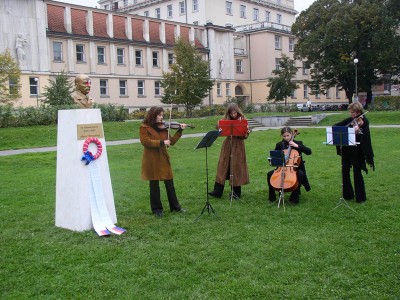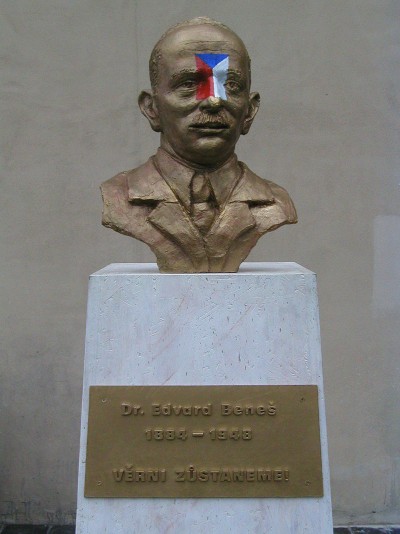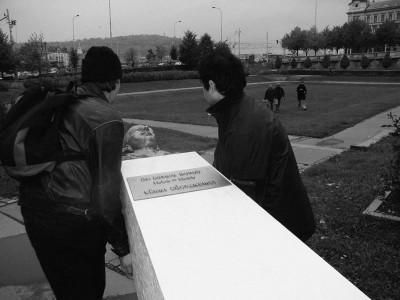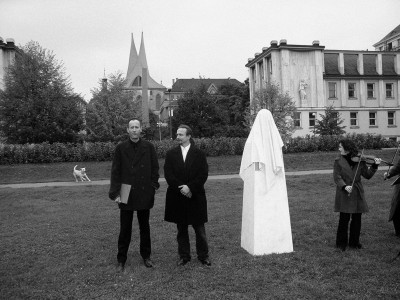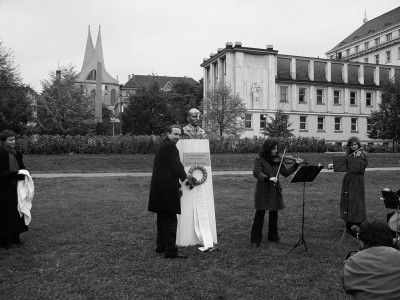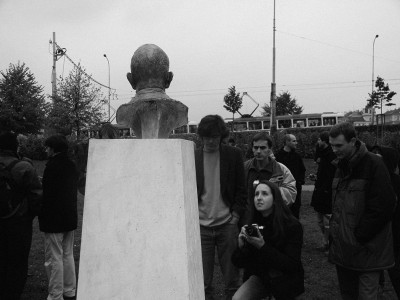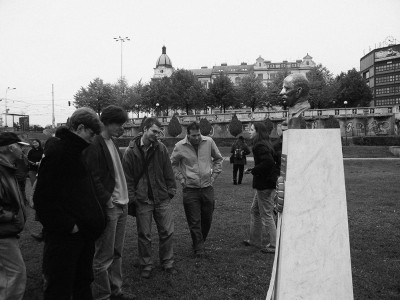FAITHFUL WE SHALL REMAIN (VĚRNI ZŮSTANEME), 2002
Object, public space intervention, guerrilla installation, event, Zítkovy sady, Prague, October 2002
At the time when all the Czech political parties officially agreed upon the sanctity of the Beneš decrees, Pode Bal unveiled a bust of Edvard Bene‰. The bust was made of plaster with a make-believe bronze coating and a Czech flag painted on its face in the style worn by soccer fans. The wooden piedestal was made to look like marble. The statue was placed in the middle of a small park in the center of Prague and was ceremoniously unveiled for the public to the sound of a female string quartet, performing a mixture of classical Czech composers from the 19th century. Members of the group then added a wreath in the colors of the state flag and left the park. The monument was removed after 11 days by the municipality of Prague.
Opening speech
/ Pode Bal (Michal Šiml)
Dear friends,
We are pleased to welcome you at today’s ceremony of the group Pode Bal.
In the past we have often been criticized that our activities are mere provocations. We knew that our works have a provocative form, however we tried to keep a certain seriousness present in the background.
In the summer of this year the time has come to think about our work and its presentation. To balance. If our work is constantly refused – couldn’t it be our fault in the end?
We have come to realize that this is actually possible and started to look for a social topic, that would carry positive aspects of our reality. We don’t want to be negativists. We have to realize that we are artists but at the same time we are also Czechs.
And a respectable topic was found. The whole Czech political spectrum came to agreement over one point. And that was the support of the Beneš decrees. Suddenly a communist holds hands with a conservative, Klaus-supporter with a Unionist. And our civil society supported them. We have to realize that we are artists but we are citizens as well.
We attempted – in a work which will soon be unveiled – to say yes to this general consensus. We chose a traditional form for our work, enriched with contemporary elements. How we managed you will soon see. The mentioned work has some attributes of a sketch, but with your possible help it can become a decoration of this little park which to this day lacks a dominant feature.
Thank you for your attention.
Ceremonious Act in Zítkovy Sady
/ Denisa Kera
Zítkovy sady in Prague is a place most people never heard of, and those who walk through the Palackého Square have
no idea of the existence of this mysterious vineyard in its lower part. This forgotten place, which until the last week belonged only to dogs and their owners, received on October 13 a truly dominant feature – an original memorial of Beneš and his decrees.
The art group Pode Bal chose this place to install their memorial of Beneš decrees with a bust of Dr. Eduard Beneš probably to bring him closer to another Father of the Nation – the huge Palacký memorial. Both, as it seems, protected their
homeland from all alien with the help of their pen, one by creating its identity through a written history and the other with a decision to recreate history by signing the well-known decrees. The memorial was ceremoniously unveiled to the sounds of Pachelbel’s Canon in D Major. The repeating melody, typical for this imitative form, has actually summed up the tone of the present-day discussions and clichés, which are repeated just as monotonously and with similar baroque haughtiness overlap and strengthen each other. In contrast to this, attached to the pedestal of the bust, was the unabridged version of Beneš decrees sections, which may still come as a surprise to some. The idea and the meaning of territorial protection, presented by the decrees were well understood by the local dogs as they marked the location properly before the ceremony began. The connection of a park which most Prague inhabitants use as public toilets for their pets and memorial statues is an unwanted irony of the meaning of similar ceremonies.
In this ceremonious act, Pode Bal wanted to join the unity which prevails in the issue of the Beneš decrees in our country throughout the political and social spectrum. The artists showed a deep remorse over their previous works which have roused the public and officials alike. They finally realized that in the first place they are Czech and that they want to express this properly as a celebrated aspect in their works. Therefore they decided to stress the devotion to the Czech Nation of Eduard Beneš by painting the Czech national flag on his golden forehead. This make-up changed Beneš to a real Indian chief who would bring any sacrifice for his territory. Thanks to this make-up, we can say that Beneš has his Czechness written directly on his forehead! The flag-painted Beneš is not a demonstration of some graffiti-crazed artists but a representation of a new kind of nationalistic “make-up”, inspired probably by the hockey fans, which accents many political manifestations today. The indulgence in overuse of national symbols and displays is well seen in the way how politicians compete to express their support to the decrees as a proof of affiliation and affection for the Czech Nation. Zítkovy sady should therefore become a place of pilgrimage where one can read this “decalogue” of Czech national pride, where all who are weak in faith, can come and absorb the strength of these words and admire the national identity and integrity as well as the legal continuity which the decrees are supposed to guarantee.
But the satirical mea culpa of Pode Bal in front of the Beneš bust exposes this political “make-up” and the cliché which makes the decrees an issue of faith through a very clear and simple act. Attached to the lower part of the painted sculpture is the real text of the decrees with the proclamation “Faithful We Shall Remain”. Everyone must decide for themselves if this is an expression of Czech national pride and adhesion to the legal principles of civilized societies of Europe, and representing our continuity with the First Republic. For example the following quotation from the “Decrees of the President of the Republic from June 21, 1945 in regard to the confiscation and hastened division of agricultural property of Germans, Hungarians as well as traitors and enemies of the Czech and Slovak nation”: “To oblige the call of Czech and Slovak farmers and lacklanders for a proper and new land reform and lead by the effort to once and for all seize the Czech and Slovak land from the hands of alien German and Hungarian farm owners as well as traitors of the republic and to give it into the hands of Czech and Slovak farmers and lacklanders, I state to the government proposal:” Do these laws live up to the present day democratic society and are they an expression of our national identity? Or do they rather belong to Zimbabwe where we can easily imagine them signed by some Mugabe? How do words like “alien”, “individuals politically unreliable”, “people of German or Hungarian nationality”, link to the Principle of Democratic Legitimacy of the State? This was set in the constitution from 1920 and its preamble says “because we want to join the society of the nations as an educated, peaceful, democratic and progressive member” and stresses the connection to the set of values as a basis for the international rule of law.
All those who want to confess to “Czechness” should have a good look at this modest memorial. The ceremony as performed by Pode Bal is closer to another act. We can see naked and uncovered body of history here – the real words of the decrees. As opposed to glorification in the form of pious ceremonies and memorial unveilments which often obscure history, this “ceremonious” act uncovers original documents and materials which constitute history. Pode Bal’s ceremony is actually a performance which should show the history not as an aesthetized portrait but as a nude. It is a comparison of these two forms of representation. This approximation to simple texts results in that the decrees cease to be a symbol of Czechness anymore and become a symbol of betrayal of democratic principles. The act ceremoniously unmasks and shows that the decrees are a work of primitive revenge, not of law and that it is necessary for every Czech citizen to read their original content in a public space, and not in an adjusted form of nationalist clichés and various political make-up. We should take a closer look at the decrees as at the memorial itself. When we get closer to it and touch it, we find out that it is not made of marble or solid stone but a plasterboard construction with a badly made cast which makes Beneš look like Bart Simpson. And it is this closer attention to the glorified decrees that the performance is trying to establish.
